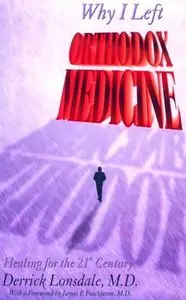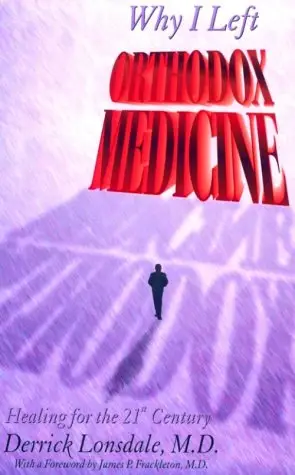Derrick Lonsdale, "Why I Left Orthodox Medicine"
English | ISBN: 1878901982 | 1997 | 255 pages | PDF | 1 MB
English | ISBN: 1878901982 | 1997 | 255 pages | PDF | 1 MB
This book is not a “do-it-yourself” book. It is really an introduction to the rapidly developing discipline called Alternative or Complementary Medicine. Complementary refers to the fact that this is an advance on the presently accepted medical approach and complements it. It tells the story of a physician who, while working in one of the “clinical meccas” of modern medicine, became disenchanted with its philosophy. In the course of his work, he became a specialist in biochemcial genetics, the science which struggles to unlock the secrets of cellular biology, the machinery which makes us “tick”.
The first chapter summarizes what the author considers to be wrong with mainstream or orthodox medicine. He traces the history of its development, pointing out the wonders that it has achieved as well as its failures. This naturally leads into a discussion of a series of conditions that occur in infants as a result of genetically determined errors in their body chemistry. The author discovered that those which could be successfully treated were responsive only to special diets and he began to wonder whether this principle could be applied to more common, every day conditions. The next discovery was that some of these genteically determined diseases were responsive to large doses of vitamins, a phenomenon known as vitamin dependency as opposed to deficiency.
Chapter 5 in this book is where the author describes the key case which led him to become an expert in the clinical use of vitamin B1, thus introducing him eventually to the wider use of all the vitamins and minerals that are known as “non-caloric nutrients.” The next chapter describes how he hegan to apply this new found knowledge to exploring disease conditions which were literally “closed books” to the orthodox physician following his traditional medical school training. It needed a completely new perspective in viewing the whole process of disease.
The whole problem of existence is how we are able to change in response to the pressures of a hostile environment. This is known as adaptation and Lonsdale explains how this works and why it has to be controlled by a computer lodged in the brain. He found that this computer, which is responsible for our emotional responses, becomes much more irritable when energy metabolism is inefficient. The commonest cause is high calorie marginal malnutrition. This recognizes that people living in America are certainly not starving and neither are they suffering from traditionally recognized nutritionally caused diseases like beriberi, pellagra or scurvy. These are the end points of nutritional deficiency. The early stages are difficult to spot and difficult to measure, causing body functions to change both in a mental and a physical sense.
Disease, says Lonsdale, is nothing more than a loss of efficiency in energy metabolism and its initial impact is on the brain computer because that is the part of the whole body which uses vast amounts of oxygen. It has to be “on duty” 24 hours a day and is continuously running our adaptive machinery. Thus, these mechanisms become erratic and unpredictable, and a whole range of disease conditions arise because of this. The teaching of Freud muddies the water here and has given rise to the idea that functional changes in the brain/body interrelationship indicates a “psychological or psychosomatic” condition. In reality, the reactions that we experience that are referred to as “emotions” are biochemical in nature. Bad chemistry creates erratic behavior that affects us both “mentally” and “physically.”
It is interesting to read that crib-death, a well known and dreaded event in 3 to 4-month old infants, is because of unpredictable and maladptive events produced in the brain computer. It is, oddly enough, the same mechanism that causes so many of our children and adolescents to become “out of control” and exhibit hyperactivity, learning disability and attention deficits, to mention but a few of these effects. For this reason, there is a chapter entitled “Crib Death and Hyperactivity,” and the mechanism is explained.
The author uses the little known mathematical technique of Boolean algebra to illustrate what he calls “The Three Circles of Health,” an interesting example of a tripartite relationship which governs our brain/body dependent health. He goes on to a discussion of the fact that there is only one of these variables that can be controlled by us, and that is nutrition, the fuel that must be calibrated to the running of the “molecular engines.”
Lastly, there is a chapter on how the laboratory needs to develop methods which embrace the completely new perspective on the basic cause of disease and how it should be addressed through nutrient research and therapy. The book is quite different from the many books which discuss the methods of self-treatment. It addresses the fundamental basis of why this new medicine works and how it must ultimately become orthodox, accepted practice.



